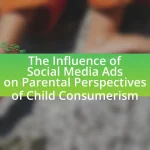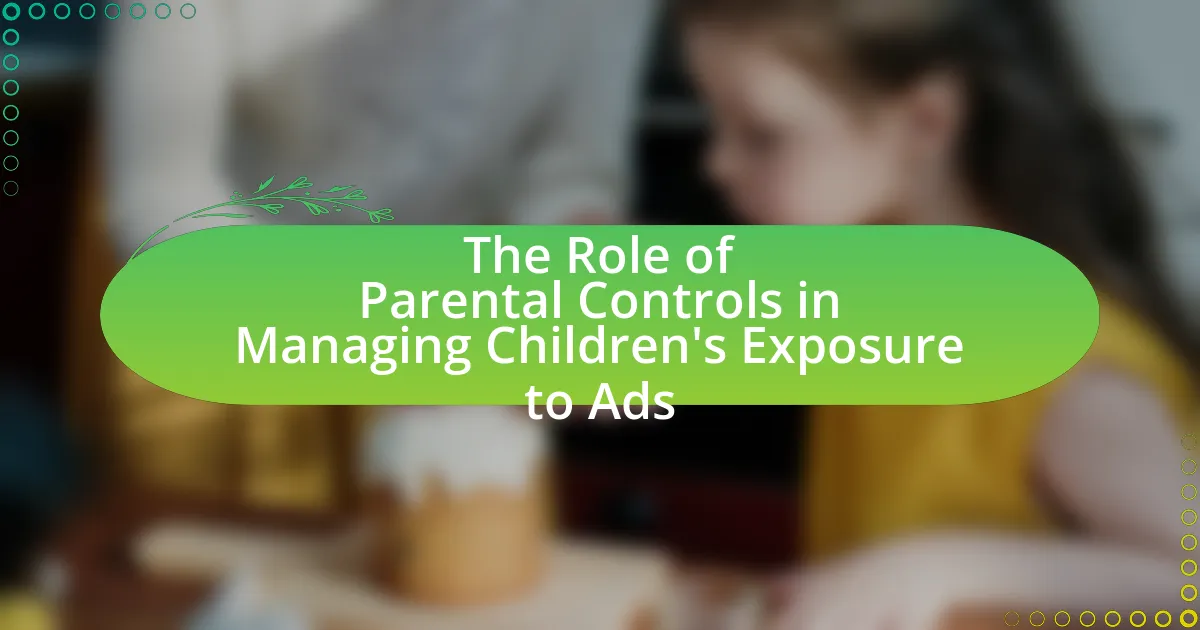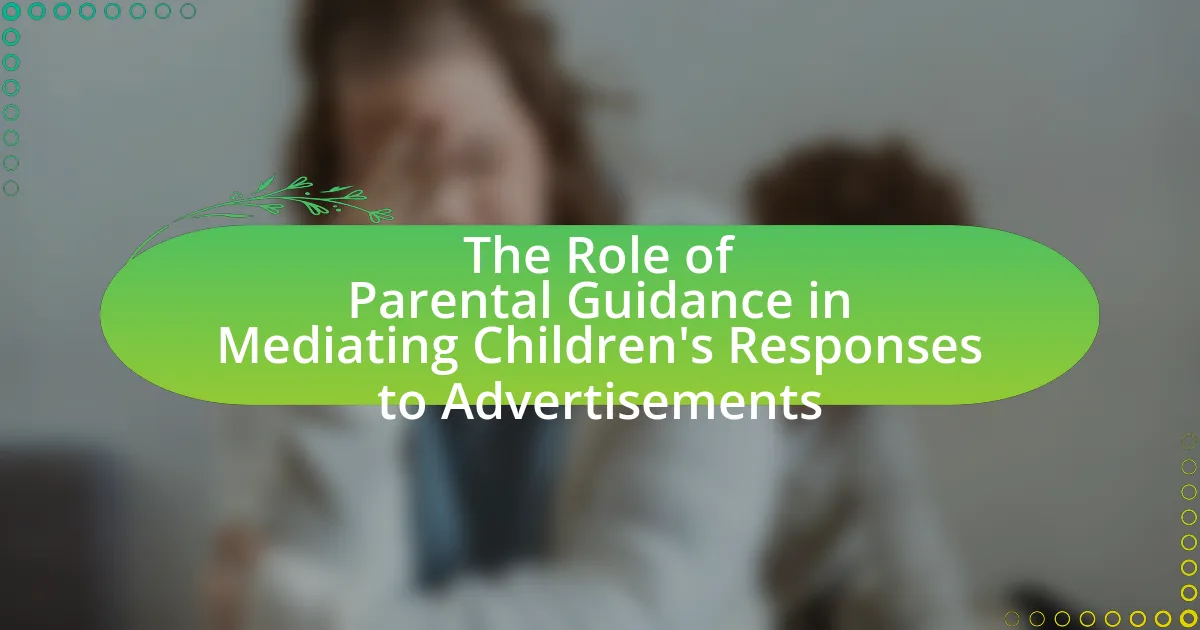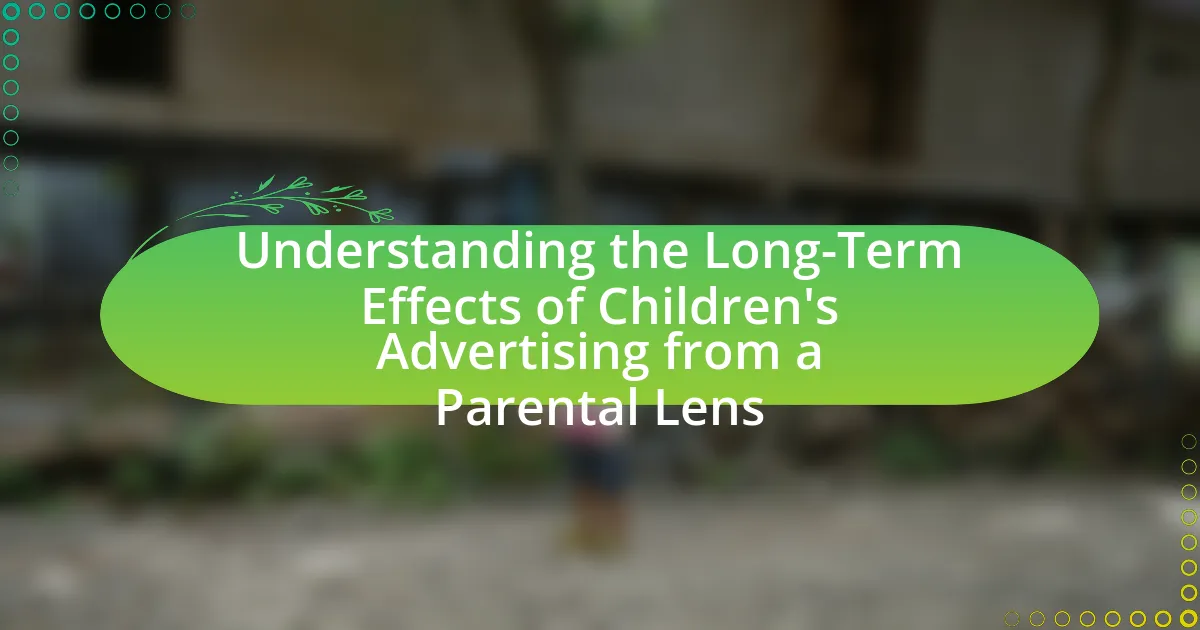Parental advocacy is a significant force in shaping advertising policies aimed at children, influencing regulations that protect young audiences from misleading marketing practices. This article examines the critical role parents play in advocating for stricter advertising guidelines, highlighting key concerns such as the manipulation of children’s perceptions, unhealthy food marketing, and the portrayal of stereotypes. It also explores the historical context of parental advocacy, current trends, and the challenges faced in promoting responsible advertising practices. By analyzing the impact of organized efforts and collaboration with policymakers, the article underscores the importance of parental involvement in creating a safer media environment for children.

What is the role of parental advocacy in shaping advertising policies for kids?
Parental advocacy plays a crucial role in shaping advertising policies for kids by influencing regulations and standards that protect children from misleading marketing practices. Parents, through organized groups and campaigns, have successfully lobbied for stricter guidelines on advertising aimed at children, leading to policies that limit the types of products that can be marketed and the methods used to advertise them. For instance, the Children’s Television Act of 1990 in the United States was significantly influenced by parental advocacy, which aimed to reduce the amount of commercial content during children’s programming and ensure that advertisements are not deceptive. This demonstrates that active parental involvement can lead to meaningful changes in advertising policies that prioritize children’s well-being.
Why is parental advocacy important in the context of advertising to children?
Parental advocacy is crucial in the context of advertising to children because it helps protect young audiences from misleading or harmful marketing practices. Parents play a significant role in influencing advertising policies by voicing concerns about the impact of advertisements on children’s health, behavior, and consumer habits. Research indicates that children are particularly vulnerable to persuasive advertising techniques, which can lead to unhealthy eating habits and materialistic values. For instance, a study published in the journal “Pediatrics” found that exposure to food advertising significantly increases children’s preferences for unhealthy foods. By advocating for stricter regulations and transparency in advertising, parents can contribute to creating a safer media environment for children, ensuring that marketing practices prioritize their well-being over profit.
What are the key concerns parents have regarding advertising to kids?
Parents have several key concerns regarding advertising to kids, primarily focusing on the potential for manipulation and the promotion of unhealthy behaviors. They worry that advertisements can exploit children’s naivety, leading to materialism and unrealistic expectations. Additionally, parents are concerned about the promotion of unhealthy food choices, which can contribute to obesity and related health issues. Research indicates that children exposed to high levels of food advertising are more likely to prefer and consume unhealthy foods, highlighting the impact of marketing on dietary choices. Furthermore, parents express apprehension about the portrayal of gender stereotypes and violence in advertisements, which can influence children’s perceptions and behaviors. These concerns underscore the need for stricter regulations and parental advocacy in shaping advertising policies aimed at children.
How does parental advocacy influence public perception of child-targeted advertising?
Parental advocacy significantly influences public perception of child-targeted advertising by raising awareness about the potential negative impacts of such marketing practices. When parents actively voice concerns regarding the manipulation of children through advertising, it prompts broader societal discussions and can lead to increased scrutiny of advertising practices aimed at young audiences. Research indicates that campaigns led by parental advocacy groups have resulted in policy changes and regulatory actions, such as the Federal Trade Commission’s increased focus on the ethical implications of marketing to children. This advocacy not only shapes public opinion but also encourages companies to adopt more responsible advertising strategies, reflecting a growing societal consensus on the need to protect children from exploitative marketing.
What historical context surrounds parental advocacy in advertising policies?
Parental advocacy in advertising policies has evolved significantly since the mid-20th century, primarily in response to concerns about the impact of advertising on children. In the 1970s, the Federal Trade Commission (FTC) began to scrutinize advertising directed at children, leading to the enactment of regulations aimed at protecting young audiences from misleading and harmful content. This advocacy was fueled by studies indicating that children are particularly susceptible to advertising messages, prompting parents and advocacy groups to demand stricter controls. The Children’s Television Act of 1990 further solidified these efforts by establishing guidelines for children’s programming and advertising, emphasizing the need for educational content and limiting commercial time. These historical developments illustrate the ongoing influence of parental advocacy in shaping advertising policies to safeguard children’s interests.
How have advertising policies evolved in response to parental concerns?
Advertising policies have evolved significantly in response to parental concerns by implementing stricter regulations on marketing to children. In the late 20th century, growing parental advocacy highlighted issues such as misleading advertisements and the impact of marketing on children’s health, leading to initiatives like the Children’s Television Act of 1990 in the United States, which limited commercial time during children’s programming. Additionally, organizations such as the American Academy of Pediatrics have called for policies that restrict unhealthy food advertising to children, prompting further changes in advertising standards. These adaptations reflect a broader recognition of the need to protect children from exploitative marketing practices, ensuring that advertising is more transparent and responsible.
What significant milestones have marked parental advocacy efforts in this area?
Significant milestones in parental advocacy efforts to shape advertising policies for kids include the establishment of the Children’s Television Act of 1990, which mandated limits on advertising during children’s programming, and the Federal Trade Commission’s 2006 report highlighting the need for stricter regulations on marketing to children. These milestones reflect a growing recognition of the impact of advertising on children’s health and well-being, leading to increased advocacy for policies that protect young audiences from exploitative marketing practices.
What are the current trends in parental advocacy related to advertising for children?
Current trends in parental advocacy related to advertising for children include increased demands for transparency, stricter regulations on digital marketing, and a focus on promoting healthier products. Parents are increasingly concerned about the impact of advertising on children’s health and well-being, leading to advocacy for policies that limit the exposure of children to unhealthy food advertisements. For instance, organizations like the American Academy of Pediatrics have called for stronger regulations to protect children from manipulative marketing tactics. Additionally, there is a growing movement towards supporting advertising that promotes positive social values and educational content, reflecting parents’ desire for a more responsible advertising landscape.
How are social media and technology impacting parental advocacy efforts?
Social media and technology are significantly enhancing parental advocacy efforts by providing platforms for communication, mobilization, and information sharing. These digital tools enable parents to connect with like-minded individuals, organize campaigns, and amplify their voices on issues related to children’s advertising policies. For instance, a study by the Pew Research Center found that 69% of parents use social media to discuss parenting topics, which facilitates the exchange of strategies and resources for advocacy. Additionally, technology allows for real-time updates and engagement, making it easier for parents to respond to emerging issues and collaborate with advocacy groups, thereby increasing their influence on policy decisions affecting children.
What role do advocacy groups play in shaping advertising policies?
Advocacy groups play a crucial role in shaping advertising policies by influencing regulations that protect consumers, particularly children, from misleading or harmful advertising practices. These organizations often conduct research, raise public awareness, and lobby policymakers to implement stricter guidelines on advertising content and practices. For instance, the American Academy of Pediatrics has advocated for policies that limit the marketing of unhealthy foods to children, highlighting the impact of such advertising on childhood obesity rates. Their efforts have contributed to the establishment of regulations that require transparency and accountability in advertising directed at young audiences.
How do parental advocacy efforts translate into policy changes?
Parental advocacy efforts translate into policy changes by mobilizing collective action and influencing decision-makers through organized campaigns and lobbying. These efforts often involve parents raising awareness about issues affecting children, such as the impact of advertising on their health and well-being. For instance, the American Academy of Pediatrics has documented how parental advocacy has led to stricter regulations on food advertising aimed at children, demonstrating a direct correlation between advocacy and policy reform. Additionally, studies show that when parents engage in advocacy, they can effectively sway public opinion and legislative priorities, resulting in the implementation of policies that protect children from harmful advertising practices.
What processes are involved in advocating for changes in advertising regulations?
Advocating for changes in advertising regulations involves several key processes, including research, coalition building, public awareness campaigns, and legislative engagement. Research is conducted to identify issues within current advertising practices, particularly those affecting children, which provides a factual basis for advocacy efforts. Coalition building involves forming alliances with other stakeholders, such as parents, educators, and health organizations, to strengthen the advocacy movement. Public awareness campaigns are launched to educate the community about the negative impacts of certain advertising practices, mobilizing public support for regulatory changes. Finally, legislative engagement entails working with policymakers to draft, propose, and support new regulations that address the identified issues, ensuring that the voices of concerned parents and advocates are heard in the legislative process.
How do parents collaborate with policymakers to influence advertising standards?
Parents collaborate with policymakers to influence advertising standards primarily through advocacy groups and direct engagement in legislative processes. These parents often join organizations that focus on child welfare and advertising ethics, such as the Campaign for a Commercial-Free Childhood, which actively lobbies for stricter regulations on marketing to children. By participating in public hearings, submitting comments during policy reviews, and mobilizing community support, parents can effectively voice their concerns about the impact of advertising on children’s health and development. Research indicates that parental involvement in advocacy has led to significant changes in advertising regulations, such as the Federal Trade Commission’s guidelines on food marketing to children, which were influenced by public input highlighting the need for responsible advertising practices.
What challenges do parental advocates face in shaping advertising policies?
Parental advocates face significant challenges in shaping advertising policies, primarily due to the influence of powerful corporate interests and the complexity of regulatory frameworks. Corporations often prioritize profit over child welfare, leading to resistance against stricter advertising regulations. Additionally, the fragmented nature of advertising laws across different jurisdictions complicates efforts to implement cohesive policies. Research indicates that only 20% of parents feel adequately informed about advertising practices targeting children, which hampers advocacy efforts. Furthermore, the rapid evolution of digital advertising technologies creates new challenges, as traditional regulations may not effectively address online marketing tactics aimed at children.
What are the common obstacles in gaining traction for advocacy initiatives?
Common obstacles in gaining traction for advocacy initiatives include lack of funding, insufficient public awareness, and resistance from powerful stakeholders. Funding is crucial as it enables outreach, research, and campaign activities; without it, initiatives struggle to gain visibility and momentum. Public awareness is often limited, making it difficult to mobilize support or engage the community effectively. Additionally, resistance from stakeholders, such as corporations or policymakers who may oppose changes to advertising policies, can hinder progress. For instance, a study by the American Academy of Pediatrics highlights that financial interests often conflict with public health goals, illustrating the challenges advocacy groups face in promoting healthier advertising practices for children.
How do industry pushbacks affect parental advocacy efforts?
Industry pushbacks significantly undermine parental advocacy efforts by creating barriers to policy changes aimed at protecting children from harmful advertising. These pushbacks often manifest as lobbying against regulations, funding counter-campaigns, or disseminating misinformation about the impact of advertising on children. For instance, in 2019, the American Psychological Association reported that aggressive marketing tactics by food and beverage companies directly countered parental initiatives to limit unhealthy food advertising to children, illustrating how industry resistance can dilute the effectiveness of advocacy campaigns. Consequently, such pushbacks can lead to a lack of progress in establishing stricter advertising policies, ultimately hindering the ability of parents to safeguard their children’s well-being.
What strategies can parents use to effectively advocate for better advertising policies?
Parents can effectively advocate for better advertising policies by organizing community groups to raise awareness and influence local legislation. By collaborating with other parents, they can amplify their voices and present a united front to policymakers. Research indicates that collective action can lead to significant changes in public policy, as seen in campaigns that successfully reduced junk food advertising aimed at children. Additionally, parents can engage with schools to educate children about advertising tactics, fostering critical thinking skills that empower kids to question misleading ads. This educational approach not only benefits children but also strengthens the argument for stricter advertising regulations.
What resources are available for parents looking to engage in advocacy?
Parents looking to engage in advocacy can access various resources, including advocacy organizations, online platforms, and educational materials. Organizations such as the American Academy of Pediatrics and Common Sense Media provide guidelines and support for parents to understand advertising policies affecting children. Online platforms like Change.org allow parents to create and sign petitions, amplifying their voices on issues related to children’s advertising. Additionally, educational materials from these organizations offer insights into effective advocacy strategies, helping parents navigate the complexities of advertising policies.
How can parents build coalitions to strengthen their advocacy efforts?
Parents can build coalitions to strengthen their advocacy efforts by forming alliances with other parents, community organizations, and stakeholders who share similar goals. Collaborative efforts can amplify their voices and increase their influence on advertising policies affecting children. Research indicates that coalitions can enhance advocacy effectiveness by pooling resources, sharing information, and coordinating actions, which leads to more impactful campaigns. For instance, the National Parent Teacher Association (PTA) has successfully mobilized parents to advocate for healthier advertising practices by uniting various local chapters, demonstrating the power of collective action in shaping policies.
What are the best practices for parental advocacy in advertising policy reform?
The best practices for parental advocacy in advertising policy reform include forming coalitions with other parents and organizations, engaging in research to understand the impact of advertising on children, and actively participating in public forums and legislative processes. By collaborating with like-minded groups, parents can amplify their voices and influence policy changes more effectively. Research, such as the American Psychological Association’s findings on the effects of advertising on child behavior, provides evidence that strengthens advocacy efforts. Additionally, parents should utilize social media platforms to raise awareness and mobilize support, ensuring that their concerns reach policymakers and the public.






